If you are a budget-oriented guy or gal, you should consider the Eufy Robovac 11 vs Xiaomi MI Robot. They may not be laden with futuristic technology, but they can at least make the dream of returning to a pristinely vacuumed home after a strenuous day at work come true.
The Xiaomi MI, the overall winner, can map your living space and then allow you to set no-go zones or schedule cleaning via the Mi Home app. This bot is also very easy to use and performs relatively well on hard floors.
The most distinguishing feature of the Eufy Robovac 11 is its whisper-quiet operation. It doesn’t offer app-connected functionality, but you can control it easily via a remote control provided in the package.
Eufy Robovac 11 Vs Xiaomi MI Robot: Comparison Chart




Eufy Robovac 11 Vs Xiaomi MI Robot: Differences
The Xiaomi MI has secured a narrow victory with a score of 3-2 against the Robovac 11. In my upcoming comprehensive comparison, I will delve deep into the commonalities and variances found between them.
Cleaning Performance
Winner: Xiaomi MI
Hard Floor
| Eufy Robovac 11S | Xiaomi MI |
|---|---|
| ≈ 91% | ≈ 94% |
Both the Eufy and Xiaomi could clean up nearly all the debris scattered across my hardwood floor. Their cleaning efficacy isn’t top-tier, but they certainly surpass numerous other robots available at a similar price point.
Carpet
| Eufy Robovac 11S | Xiaomi MI | |
|---|---|---|
| Low-pile Carpet | ≈ 78% | ≈ 86% |
| High-pile Carpet | ≈ 62% | ≈ 82% |
Their performance was subpar throughout my floor tests since they didn’t have strong enough suction to pick up debris embedded deeply within my carpets. A substantial amount of debris was still evident after these vacuums had traversed my carpets a few times. In comparison, my Roomba S9 successfully captured 99% of the total debris on my carpets, thanks to its formidable suction.
Hair
| Eufy Robovac 11S | Xiaomi MI | |
|---|---|---|
| 5-inch strands | ≈ 62% | ≈ 54% |
| 10-inch strands | ≈ 34% | ≈ 41% |
I would never suggest these bots to people looking for a robotic vacuum to clean up the messes left behind by their furry friends. My tests showed that both were very bad at picking up hair, especially for 10-inch strands. Additionally, a considerable amount of hair wound up entwined in their rollers. Untangling them isn’t daunting, but it isn’t particularly easy either. The Xiaomi is equipped with a brush cleaning tool featuring a small hook blade, which was a big help in removing entangled hair and stuck-on debris.
Design & Usability
Winner: Xiaomi MI
Dimensions & Weight
| Eufy Robovac 11S | Xiaomi MI | |
|---|---|---|
| Dimensions (W xH) | 13 x 3.1 inch | 13.6 x 3.8 inch |
| Weight | 6.7 lbs | 8.4 lbs |
They are both built with traditional circular frames. The Eufy boasts a sleek, black aesthetic reminiscent of the premium robots in the iRobot series, whereas the Xiaomi parallels the appearance of the Roborocks with its shiny white casing and laser tower. The former features a front-facing bumper, while the latter uses a bumper ring encompassing its frame, ensuring neither the robots nor your belongings are harmed during collisions.
The Eufy Robovac is lighter in weight but still feels solid and durable. This one also has a small stature and is one of the most compact robots I have ever tested. And through my evaluations, they were slim enough to travel beneath a variety of low-profile furniture, including my bed, couches, coffee tables, and TV stands.
Extractor & Side Brush
They are underbelly equipped with old-fashioned spiral brush rollers to suck and send grime into their dust compartments. The bristles on them resulted in a significant amount of hair ending up on them during my testing, though untangling them was relatively hassle-free.
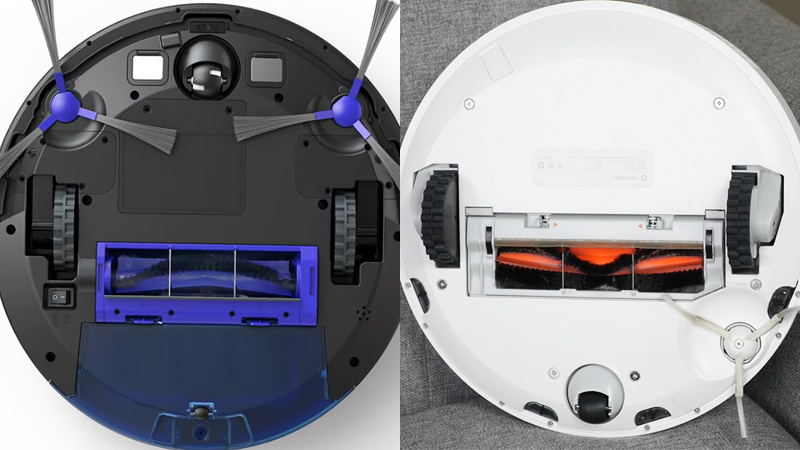
Both boast a circular design, so they need side brushes to catch dust and dirt in the corners and edges. This brings us to another distinction between the two bots: The Eufy contains two 3-arm corner brushes, whereas the Xiaomi uses a single 3-prong one. Having two side brushes adds a little reach to the Eufy, but their tendency to spin too quickly leads to a small amount of debris being scattered before the robot has to work harder to collect it.
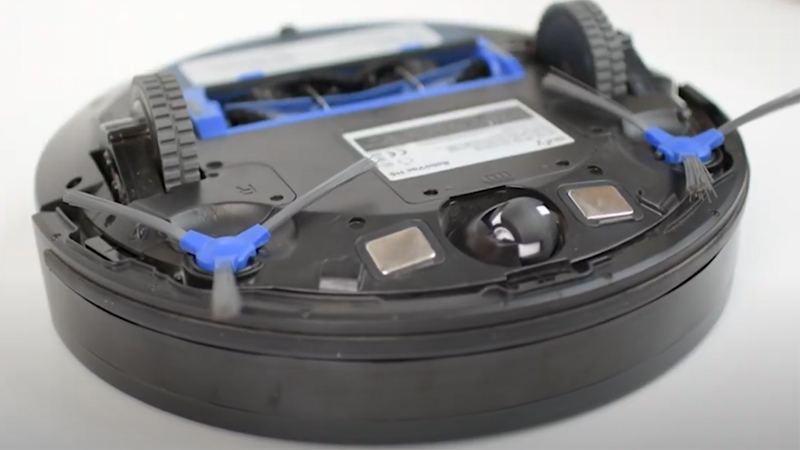
Navigation
The Xiaomi MI uses a laser distance sensor that sits on top of the machine to scan its surroundings at 360° at 1,800 times per second to map out your home – this is similar to Roborocks using LiDAR technology to map and navigate.
On the other hand, the Robovac 11 has no laser tower or built-in camera. This one relies on a more basic navigation system, using infrared sensors and bumpers to navigate around your furniture or obstacles. So, of course, it doesn’t have a map-saving function.
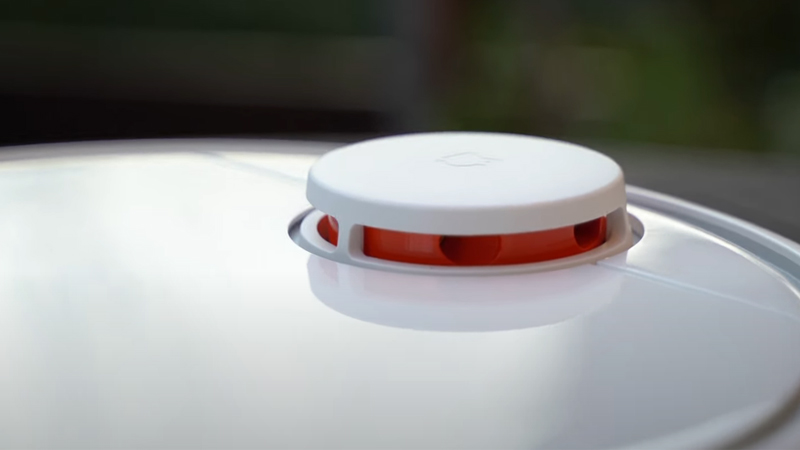
These bots have no obstacle avoidance technology seen in the Roomba J7+ or Roborock S7 MaxV, so bumping into various items within your home is inevitable. The good news is that their bumpers excel at preventing damage to themselves and to your household items during such encounters.
It is worth noting that the Eufy will turn off when it’s stuck in order to conserve battery life. Once it’s rescued and powered back on, it resumes its duty until the battery level is critically low. I highly recommend meticulously preparing your space before they start a cleaning trip. I mean, you should remove shoes, bags, wires, and any other potential obstructions your robot might encounter.
Battery Life
| Eufy Robovac 11S | Xiaomi MI | |
|---|---|---|
| Battery Life | ≈ 64-98 mins | ≈ 84-149 mins |
| Charging Time | ≈ 221 mins | ≈ 178 mins |
The Eufy uses a 2600 mAh lithium-ion battery, whereas the Xiaomi relies on a massive 5,200 mAh battery, one of the largest batteries I have tested to date. Consequently, it comes as no surprise that the Xiaomi has a longer battery life between charges, although it isn’t extraordinarily impressive.
The battery is, no doubt, among the most crucial components of a robot vacuum, and like all components, it has a lifespan after which it requires replacement so the bot can continue to carry out its mission. The Eufy battery claims to last 3 years, while the Xiaomi battery will last for 2 years before needing a replacement. Naturally, the actual lifespan may vary depending on the frequency of use and the duration of each cleaning cycle.
Speaking of the ability to be recharged, the Xiaomi has a “Recharge & Resume” function, meaning as long as you have the app set up, this one will automatically return to the charging dock for a battery top-up when running low and subsequently resume cleaning from where it left off to complete the task. As for the Eufy, you need to use the remote control to send it home.
Control
Winner: Xiaomi MI
Manual Control
Regarding the control panel on these robots, the Eufy offers a single button on its chassis to turn it on, and most of the interactions occur through the provided remote control. Meanwhile, the Xiaomi has a home button to navigate the bot back to its base and a power button to control its cleaning modes: a single press for automatic cleaning, two presses for spot cleaning, and a prolonged press to switch it off.
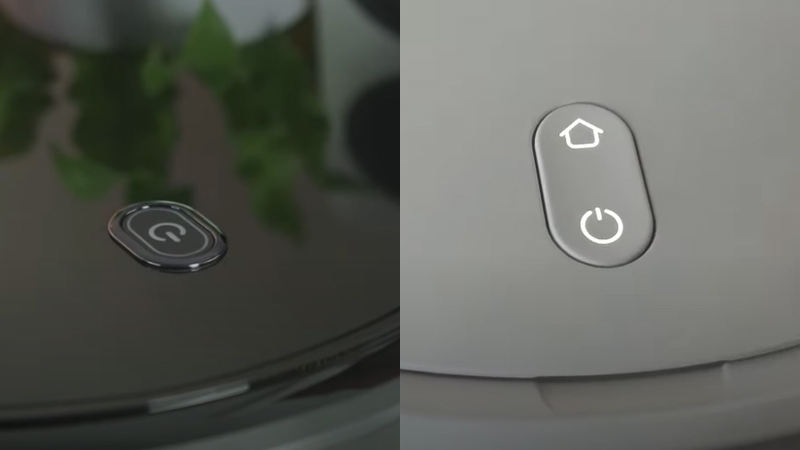
App Connectivity
For remote control, you can pair the Xiaomi MI with your phone via the Mi Home app. The app allows you to remotely turn on the bot, send it home, schedule cleaning, set “keep-out” zones, or install “virtual walls.” You can also switch between four different suction powers: silent, standard, turbo, and max.
As for the Eufy, it doesn’t support Wi-Fi connectivity or any app-interfacing features, leaving no room to dictate its route, establish restricted areas, or identify zones that necessitate more thorough cleaning. Instead, this bot uses a basic remote control that runs on a pair of AAA batteries.
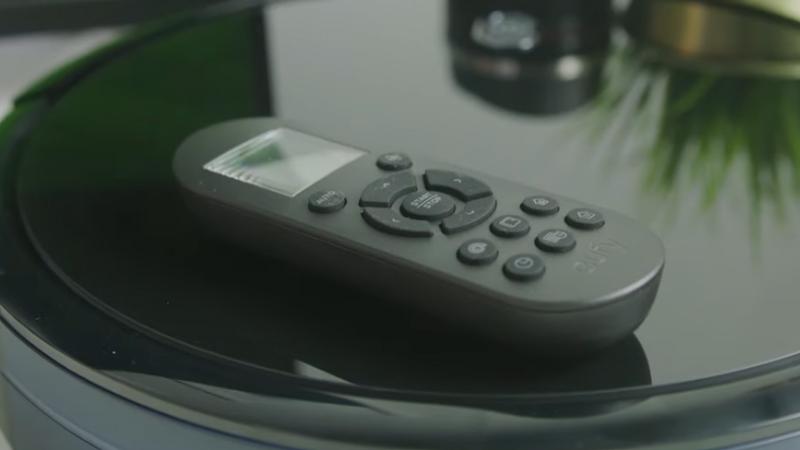
The remote control includes a series of buttons to commence or halt a cleaning session, activate the automatic mode, send the bot home, schedule cleanings (once per day), and toggle between four distinct modes: single room, spot cleaning, max, and edge. You can also drive the robot yourself to clean specific zones in case you want to clean up a BBQ sauce spill in your kitchen, for example.
Cleaning & Maintenance
Winner: Eufy Robovac 11
Both the Eufy and the Xiaomi use compact dust boxes (with capacities of 0.6 and 0.42 liters, respectively) for waste collection, saving you the additional expense of purchasing dust bags. These bins need to be emptied manually since these bots have no self-cleaning feature, the norm with most budget-friendly robot vacuums.
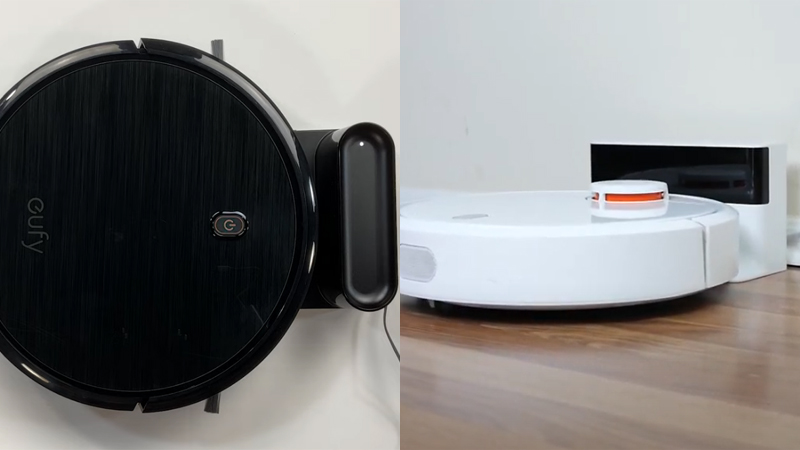
Manually emptying them is a breeze and doesn’t seem much of an issue, but this can release trapped particles or allergens back into the air, posing challenges for those with serious allergies. If you fall into this category, you might want to consider a robot equipped with a self-cleaning base, like the Roomba J7+.
Both have a HEPA filter to ensure that small particles are trapped inside the dustbin and do not escape back into the air, with Eufy featuring an additional washable foam filter. By the way, the Eufy comes with two spare filters (one HEPA, one foam) along with two additional side brushes, so you have one cost-free replacement available.
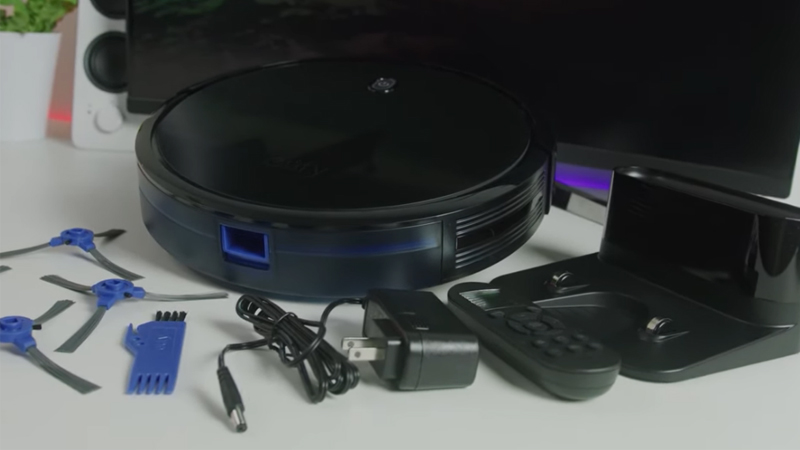
Other Features
Winner: Eufy Robovac 11
Noise
| Eufy Robovac 11S | Xiaomi MI | |
|---|---|---|
| Working | ≈ 54-59 dB | ≈ 55-64 dB |
| Self-Emptying | None | None |
Perhaps the most significant advantage of the Eufy is its ability to operate at a whisper-quiet level while cleaning your house. Even when it is in Max mode, it is not as loud as most robots I have tested. The Xiaomi isn’t really too loud either – it just doesn’t offer the same level of quietness as its rival.
Mopping Ability
Both are not vac-and-mop robots, so they can’t vacuum and mop your floor at once. They focus on suction and do not have a water reservoir or mopping pad attachment to handle wet cleaning.
Quick Rundown Of Xiaomi MI
- Industry leading SLAM algorithm, with 12 different sensors and 3 processors, scans the room and plans the best cleaning path.
- Strong 1800 air pressure DC motor and self adjusting hover brush to tightly seal with floor for perfect sweep.
- Real time cleaning status by watching the cleaning path and progress done.
- Set timing for cleaning to let the robot work while you are not home.
- 5200 mAh battery for 2. 5 hours of cleaning time. Sophisticated multi protection design for long term and safe use.
Quick Rundown Of Eufy Robovac 11S
- "Best Robot Vacuum of 2018" by Digital Trends.
- All-New RoboVac: Re-engineered to be the slimmest* RoboVac (2.85") but with quiet operation and increased suction at 1300Pa for up to 100 minutes** of constant, powerful suction.
- BoostIQ Technology: Automatically increases suction power within 1.5 seconds when extra vacuuming strength is needed to get the best clean.
- A Quiet Clean: Vacuums for up to 100 minutes** on hardwood floors with consistant, powerful suction at a volume no louder than an operating microwave. Premium Features: Anti-scratch tempered glass-top cover for protection, infrared-sensor for evading obstacles, and drop-sensing tech to avoid falls. Automatically recharges so it's always ready to clean.
- What You Get: RoboVac 11S, remote control, charging base, AC power adapter, cleaning tool, extra set of high-performance filters, 4 side brushes, welcome guide and our worry-free 3-month warranty.
Product Videos
References:
- Eufy Robovac 11: https://us.eufy.com/products/t2108111

Richard B. Schmidt is a prominent figure in the vacuum cleaner industry, boasting over 15 years of expertise. Armed with a Robotics Engineering degree from Northeastern University and a Master’s in Consumer Science from Harvard, his unique blend of technical knowledge and consumer insights positions him as a sought-after authority in vacuum cleaner evaluation. Richard’s career began at Dyson, where he contributed to the development of innovative vacuum models. Transitioning to advocacy and reviews, he co-founded the first Vacuum-focused blog in 2008, offering comprehensive analysis and user guides for various vacuum cleaners. In 2020, he founded RoboMop.net, providing ongoing insights through columns and buyer’s guides.
